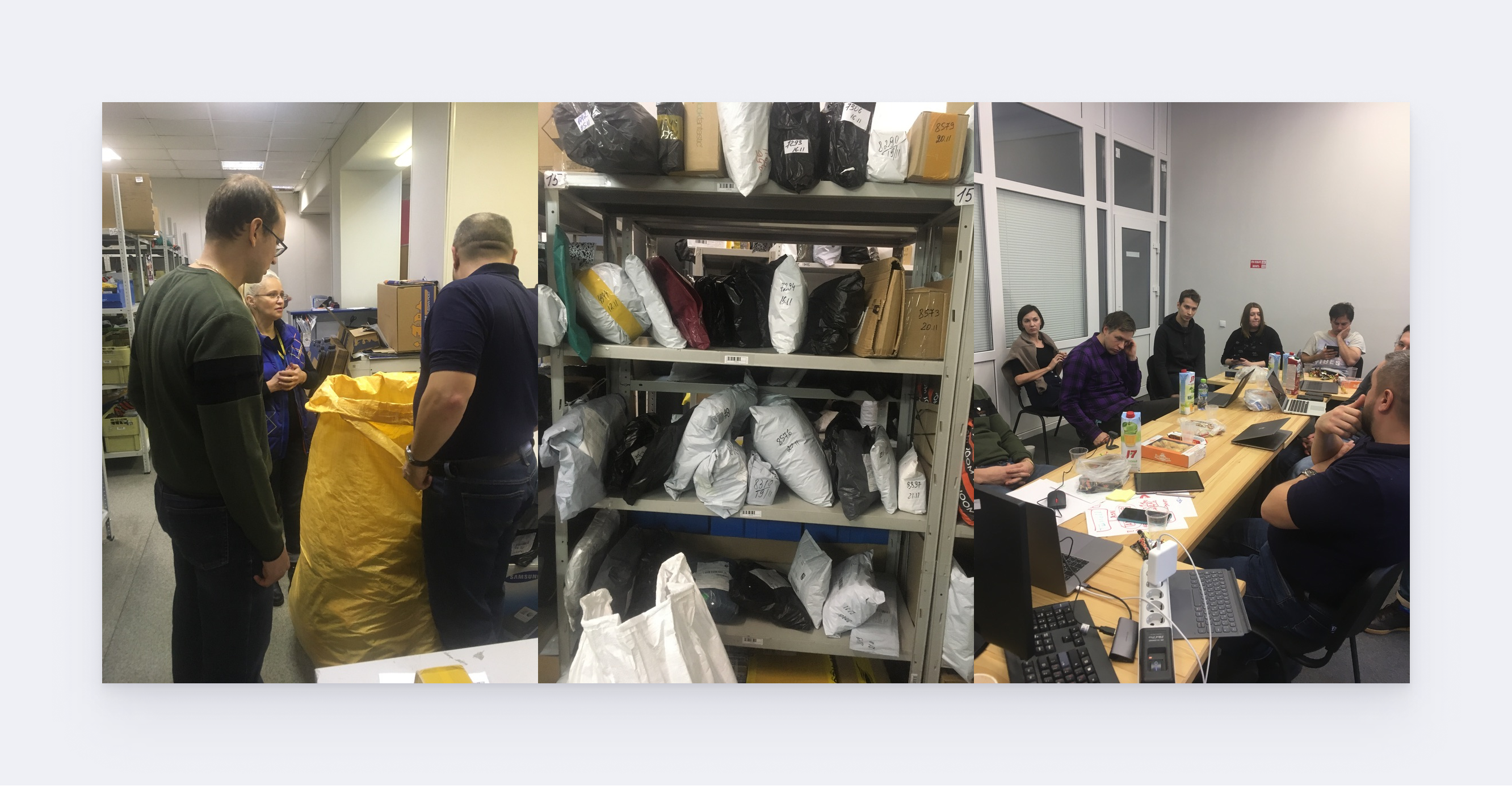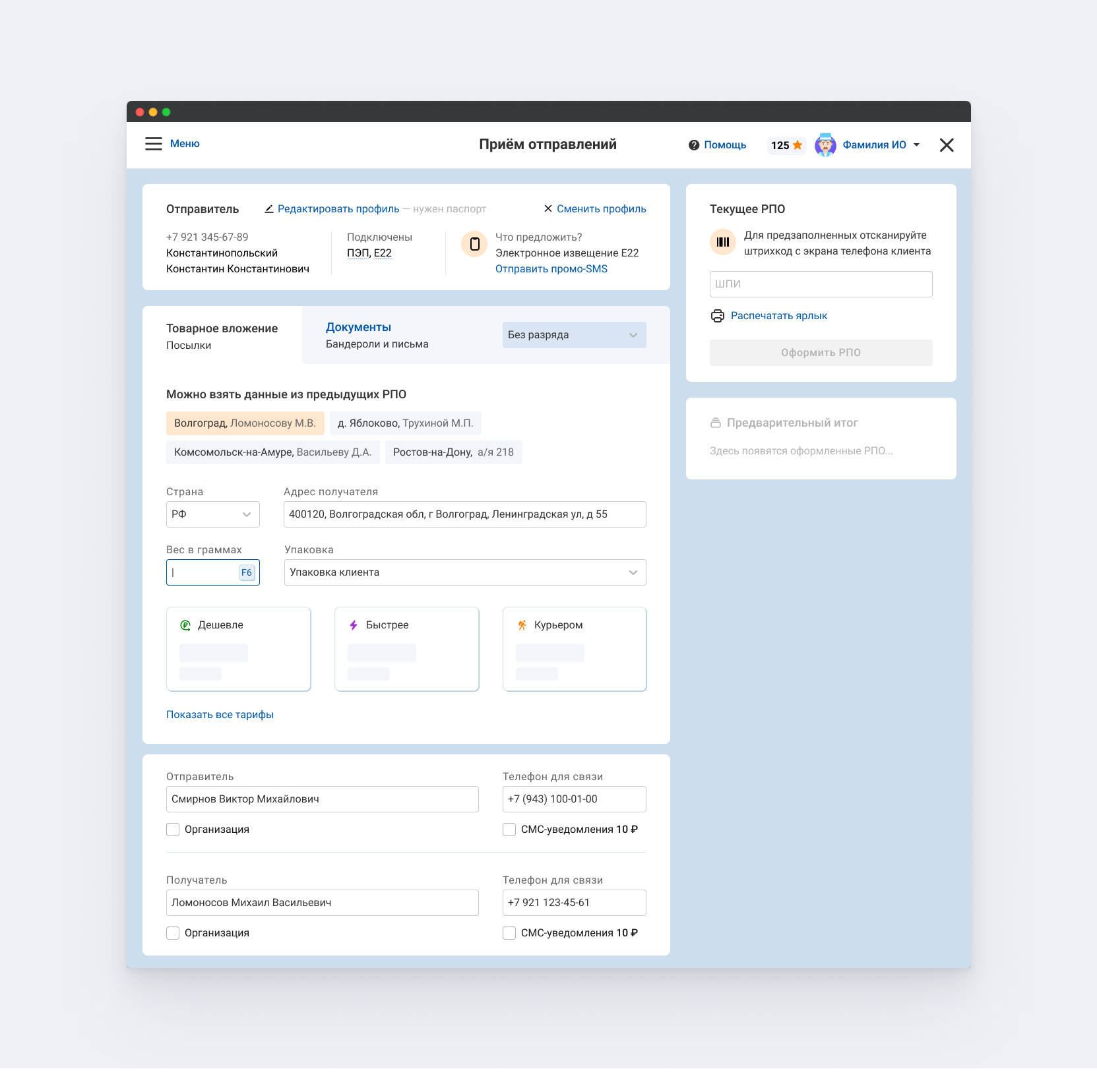 Team
Team
Clients: More than 80 000 postal workers, over 100 millions Russian Post customers
Business customer: Postal business department
Team: Product manager, Product owner, Analysts, 3 Product designers, Developers, Customer Support
Invited teams: E-commerce department, RnD department, Postal office workers
Methodology: Scrum, SMART, JTBD, USM, CJM, SB
Business Goals:
- Optimisation of the parcels shipping tariff scale to make it flexible and transparent. Postal business revenue increase
- Time of service session decrease
- Postal workers training time decrease
- Operational costs decrease
- Bonus program pilot for postal workers
Discovery research
We used a versatile approach, combining multiple methods like employee interviews, direct working process researches, etc. in order to reveal insights and customer pains from different angles. First of all team members were engaged in visiting different postal offices and sending parcels to each other using different user scenarios.
 Part of the team used Russian Post services very rarely. Feedback from «newbies» was particularly valuable because there was a fresh look at the postal processes and helped us to build an empathic mindset in the team.
Part of the team used Russian Post services very rarely. Feedback from «newbies» was particularly valuable because there was a fresh look at the postal processes and helped us to build an empathic mindset in the team.
Also at this stage we actively communicated with customers support team. Team provided invaluable information on user pains.
The results of research sessions were formed into CJM’s for every stage of the sending parcel journey.
 In the current implementation of the plugin, the focus of the scenarios was on the parcel and its data. We have made the starting point of the client’s needs.
In the current implementation of the plugin, the focus of the scenarios was on the parcel and its data. We have made the starting point of the client’s needs.
Team identified the most painful spots of the customers journey:
- Onboarding in the postal office
- Increased service time
- Tariff and options selection
- Parcel tracking
Sending parcel process affects areas of responsibility of different departments. So I facilitated brainstorm session with teams from Postal business and E-commerce depts, and the RnD team.

The insights obtained in cross-team workshop sessions and CJM data were compiled into the Service Blueprint.
Hypotheses common view
Early client authorization
When a customer wants to send a parcel, authorization is not required by postal rules. We developed optional early authorization, so that we could collect the data about the destinations, services provided and other customer preferences. Using this data, we developed a set of presets for sending parcels, which significantly reduced service time. In addition, we were able to start offering more relevant services to customers, like paying bills, magazines subscription during one service session.

Flexible Rate Grid
We organized postage rates into three categories — «faster», «cheaper» and «courier delivery». This allowed our customers to better understand the rate schedule and to choose the best options for their shippings.
Bonus system for customers
We started charging bonuses to customers for choosing more faster shipping, courier delivery, as well as for additional packages of services. Also we started to collect customer preferences in order to offer them relevant services which they could pay by bonuses. In addition, bonuses were given for the authorization itself to encourage clients to try more postal services.
Bonus system for operators
We developed a system of bonuses for services provided by postal operators during . This allowed us to increase the operators’ engagement, improve the quality of service and raise NPS.
Prototyping and testing
We started testing wireframes and conducted series of A/B in postal offices, differing in regions, workload and equipment. To test our hypotheses in production, we started to deploy our solutions by separate blocks. The test environment included 20 communication offices across the country to take into account the context as much as possible. In this way, the team was able to implement a cycle of rapid hypothesis testing.
MVP features
- Client identification, fast registration process via SMS
- Prefilled parcel data via customer’s previous sendings
- As a first step in optimising tariff grid — split it to three simple categories and through context prompts guide postal workers through service process
- Basic bonus system for clients
Checkpoint
- Prototypes were field-tested and verified with data from usage of the new features in current design
- Team validated the hypotheses with metrics
- Release 1.0 with new interfaces is compiled and deployed on several postal offices in different regions
- Feedback collected and processed